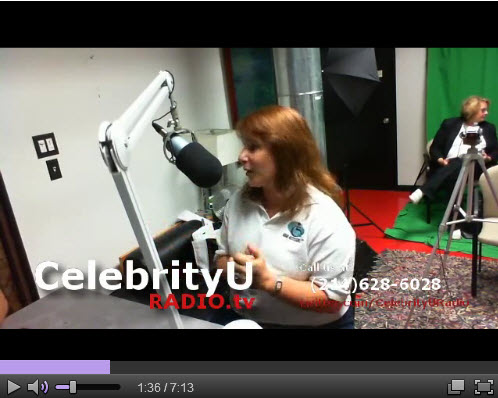This guest blog is brought to you by my friend William J. Martin, WJM Architect (photo credit Mike Pollio). I met William on Twitter and have been following his amazing work for over two years. He is amazing and I’m grateful and flattered that he decided to write a blog post for our site. Enjoy!
What prevents businesses from making the changes that make their businesses handicap accessible has many parts. Many business owners tell me it’s about money and construction cost — a big investment without any financial return. I do understand that no one likes to spend money on things they don’t believe necessary to operate their business, but what if it turns out to be good business?
Sometimes events occur that help to illustrate the value of consulting with an accessibility design professional to bring your business into compliance with the accessibility codes and the Americans with Disabilities Act (ADA) requirements.
I recently had a project that involved ADA upgrades to a long established restaurant. This particular project was not that much different than many of the other projects that I had designed in the past, with one exception…. It was severely damaged by fire and was over 140 years old. It was damaged, but not destroyed. The beloved building would be repaired and rebuilt.
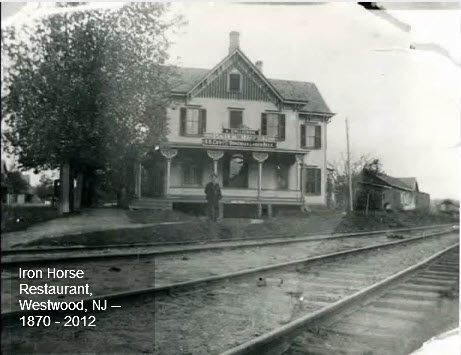
Whenever there is a fire in a building, it is a tragedy. If the building is 140 years old and has a fire, it is a serious tragedy. Buildings like that are vital to the heritage of their community. Having something as permanent as a beloved local building damaged by fire can be extremely unsettling for many people.
My client called me the day after the fire and said “This building is 140 years old, we have been here for 40 years, we just had a severe fire. You have to help me!”
After I saw the damage and got over my personal shock, I comforted the owners, “don’t worry,” I said, “the structural damage can be repaired.” I then began to contemplate the task at hand. My client would have loved to blink his eyes and have everything put back exactly as it was before the fire. However, the extent of the damage was more than sufficient to require building code upgrades, including accessibility upgrades. The multilevel interior dining rooms would have to change. Toilet facilities would have to be addressed.
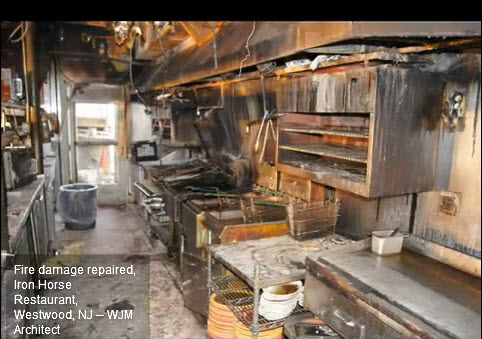
After assisting in obtaining the cleanup and selective demolition permit, the very next thing I did was to prepare a comprehensive building code analysis to identify the exact upgrades that would be required based on the extent of the damage. This had to be done first, since it affected the overall approach to the fire damage repair and rebuild design work. I met with the building officials and had them review and sign off on the code analysis and required upgrades. This way I had a clear and unchanging set of requirements specific to this project. The full extent of required upgrades were established and I could now begin the redesign work.
With significant concern in his eyes my client said… ”I can’t lose paying customer tables and seats for ramps and toilets that I did not have before the fire. You have to help me! I assured him I would do the very best I could to resolve all issues and get the restaurant open as soon as possible. His response was direct, “If it was so easy, don’t you think I would have made those handicap changes already.” [Note: we prefer the word accessible rather than handicap]
This was a normal reaction from a very savvy businessman assessing a difficult situation. For an accessibility design professional , this was a design problem to be solved.
Armed with my ADA/ANSI code analysis, I began to look for solutions. The dining rooms were 2 steps up and down from one another. It seemed like there were steps everywhere. The ladies toilet rooms were on the second floor, a full flight of stairs up from the dining rooms. The mens toilet room was actually 2 small individual toilet rooms just off the dining room. The 140 year old wood framed building had been a Victorian house, a hotel, rooming house, bar, and finally, most recently, the fire damaged restaurant.
Built right up to the street line, there was no front yard for any kind of ramp.
The main building had long ago been connected and combined with the buildings next door. These connected buildings were why every floor was at a different level. They were built as separate buildings and combined later into the dining rooms, kitchen and bar of the restaurant.
The old connected storefront was previously converted into an emergency exit and alarmed to prevent casual use. Even though there was a step to the doorway, the recess of the storefront allowed for a ramp to meet the sidewalk. There was my new accessible entry. The four steps up at the existing traditional entry could remain as I designed this entry adjacent to serve as a new ramped entry. There were no tables allowed in front of this emergency exit, so no tables and chairs were affected by this change.
Next the dining room levels had to be addressed. I could get a ramp in from outside, but now I had to find an accessible route within the space. The 14 inch difference between floor levels meant a 14 foot long ramp in the dining rooms with landing space, railings, turning clearances, etc. This would certainly affect tables and chairs in the dining rooms and this was what my client felt was devastating to his restaurant seat count. I began to get a headache.
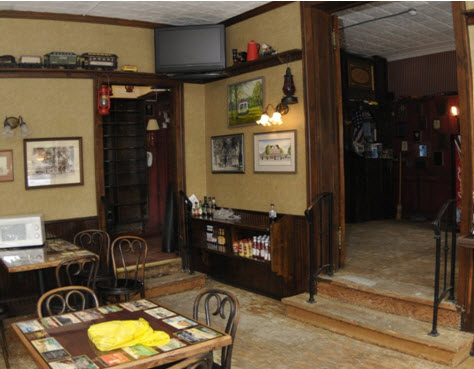
Since circulation space could also serve as ramp landing space, I analyzed the circulation around the tables and the kitchen area. The kitchen was also 2 steps higher than the dining room. The hallways connecting the dining rooms to the kitchen could not be used for tables regardless.
Instead of a single 14 foot long ramp, I designed two 7 foot ramp sections — one in each dining room using these existing hallways. The two ramps met at a new mid level where I created a comfortable landing with proper turning radius. Kitchen entry was shifted over slightly. The fire had begun in the kitchen and this doorway move could be done easily during the kitchen redesign.
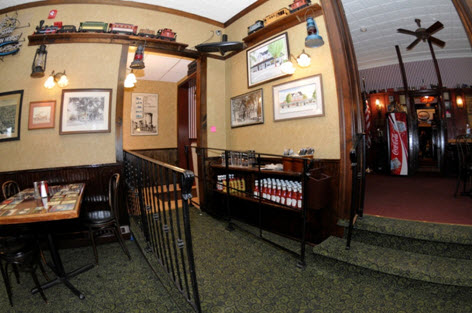
Adjacent to the new ramp landing space was a large storage closet where beverages were dispensed and glasses stored. I relocated the beverage function into the new efficient commercial kitchen design and used this closet space for a unisex accessible toilet room.
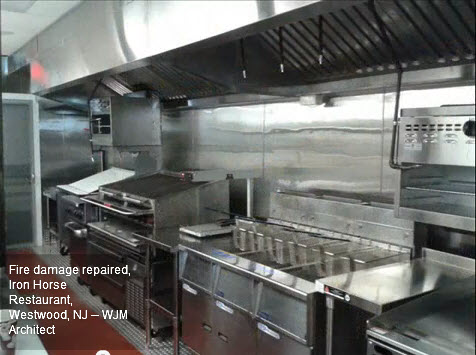
I aligned the toilet room floor at the new landing mid level, with the door to the toilet room opening off the ramp landing. There was proper clearance for the ramps, turning, handrails, and the required toilet room door approach clearances. The closet interior was slightly larger than was needed for the a compliant toilet room.
I now had the interior accessible route connecting the dining room levels and the required unisex handicap toilet room. This was accomplished without displacing a single customer seat.
After I confirmed all of the many overlapping ADA clearance requirements, I grabbed my sketch and met with the owner to explain how it would work. At first he could not believe it. The ramps were much shorter than he was told would be necessary. When I explained the new mid level between the two ramps, his eyes grew big as he realized that it was possible after all.
Nearly any building can be made accessible, it’s really a matter of architectural creativity and open minded problem solving.
The fire damaged restaurant, with the handicap accessibility changes, was completed and re-opened. Like any beloved neighborhood business, the outpouring of public support resulted in increased business in the weeks and months since the re-opening.
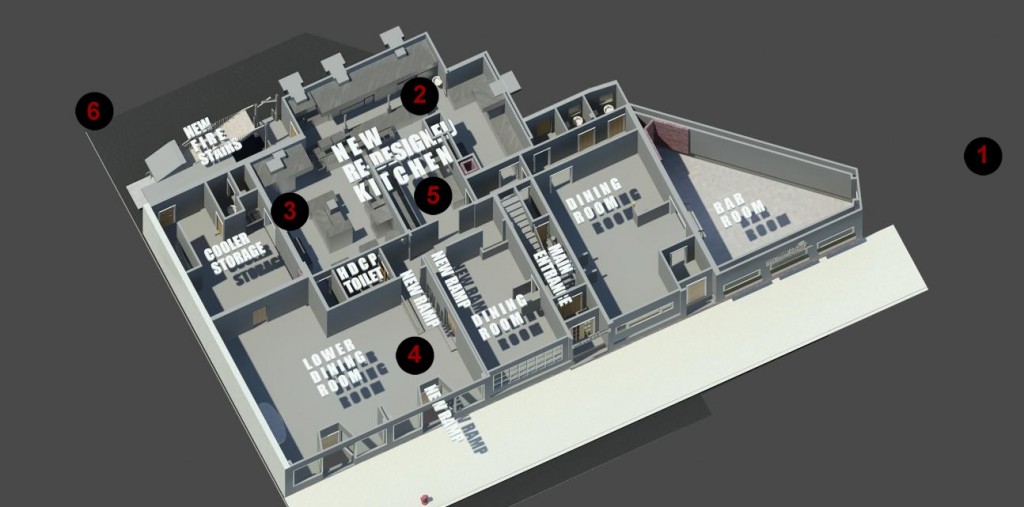
I suggested to the owner that they include in their advertising a few words about the new accessible features. The result has been a sustained increase in their business. Able bodied people now bring disabled relatives to eat. More elderly patrons, many with only minor mobility issues, now flock in groups to enjoy the best burgers around. Some people come just to see the inside of the 140 year old building. They never thought they would be able move freely between the levels and now they come just because they can.
In the end my client told me the changes that were made, made good business sense. People who had difficulty entering the restaurant because of the front steps now come to dine and bring with them their families and friends AND their dollars…
Accessibility professionals know that making your business accessible isn’t just part of the building code, it’s good for your business.
Over the years I have assisted businesses and witnessed them benefit substantially from handicap accessible modifications made to their buildings, especially service businesses.
There is a province in Canada named Manitoba. Over 170,000 people in Manitoba have a disability. That’s almost one in six people. Over the next 20 years as people grow older, the number will rise to one in five Manitobans. Manitoba does not have rules mandating access like we do here in the US. Barrier Free Manitoba, a non-profit organization that is helping to enact laws to remove barriers put together a campaign to request messages for encouragement so that the government in Canada will act.
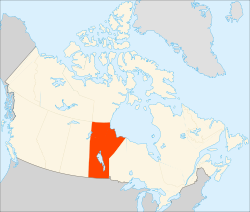
On May 28th, Barrier-Free Manitoba invited disability-related groups and advocates from outside the province to send messages of encouragement to Minister Howard and the Manitoba Accessibility Advisory Council (MAAC). Here are some of the messages from all over the world!!!
Global Messages of Encouragement
June 5, 2012
It’s a Small and Hopeful World
It’s a small and hopeful world. And with over 1 billion persons with disabilities living in countries around the globe, accessibility-rights are truly an international issue.
It’s also an increasingly connected world. Progress on accessibility-rights in one jurisdiction supports similar progress elsewhere. Conversely, we are all harmed whenever there are set backs in the struggle to promote and protect the human rights of persons with disabilities.
In recognition of our common interests, Barrier-Free Manitoba recently invited disability-rights advocates from outside of Manitoba to send messages of encouragement to Minister Jennifer Howard and the Manitoba Accessibility Advisory Council (MAAC).
We take very seriously the Government of Manitoba’s pledge to make the province a leader in promoting and protecting the human rights of persons with disabilities. With the proposed accessibility-rights legislation, the government has the opportunity to take a giant step forward – both toward achieving this goal and toward leading-edge implementation of the Convention on the Rights of Persons with Disabilities (CRPD).
This is a remarkable opportunity that, if embraced with vision and resolve, will both provide significant benefits to all Manitobans and support further progress around the world. The advocates who have accepted our invitation heartily agree.
Barrier-Free Manitoba is pleased to forward the global messages of encouragement received by June 5, 2012, the deadline given for public feedback by the MAAC.
Selected Messages of Encouragement
I have lived with circumstances of disability all of my life, and I take both personal and professional interest in the issues that persons with disabilities face in pursuing their life interests. I am a practicing lawyer, these days focusing my practice on being a Settlement Counsel www.julianbodnar.com. I also take interest in disability issues in the context of www.disabilitywellness.com.
Accommodations and respect for my needs and interests arising from my circumstances of disability continues to be the most significant challenge I face in my life; particularly so now as I am challenged with mobility issues on account of both my disability, and also the factors of natural aging, which of course, are compounded by circumstances of disability. It can also be particularly disconcerting at times to experience the lack of accommodation and respect for disability interests especially from my perspective as a practicing lawyer where for the most part we have to resort to a hodge-podge of disability related provisions scattered amongst various pieces of legislation where the subject of disability just happens to be of significance.
I would therefore commend and fully endorse the progressive thinking and ambitions of the people of Manitoba in developing human rights legislation for people with disabilities. I am especially encouraged that Manitoba’s ambitions here may well be the beacon for our other provinces and Canada as a whole to show example of a much needed new respect for the interests of persons with disabilities in society.
Julian W. Bodnar, Saskatoon, Saskatchewan,
Settlement Counsel * Mediator *Arbitrator
The legislation being developed in Manitoba needs to be strong and effective. This can be accomplished by having the legislation address each of the seven elements set out by Barrier-Free Manitoba. Based on the Ontario experience, the legislation needs to include the goal of becoming a fully accessible province, as well as a target date by when this will be achieved. Our end-date has served as an important tool in our efforts since the Accessibility for Ontarians with Disabilities Act was passed in 2005.
David Lepofsky, Toronto, Ontario, AODA Alliance
I wholeheartedly support the proposals of Barrier Free Manitoba. The disabled are our brothers and sisters, mothers and fathers, friends and co-workers. We, as a society, should make a concerted effort to make their lives easier so that they can enjoy the same freedoms as everyone else. It is my sincere hope that the proposed legislation will establish a barrier free province that can be held up to the rest of the world as an example of how the needs of the disabled are attended to in civilized society.
Charlotte Gerber, Cameron, New York, USA, Disability Columnist, About.com/New York Times
The legislation being developed in Manitoba needs to be strong and effective. This can be accomplished by having the legislation address each of the seven elements set out by Barrier-Free Manitoba. In LibredeBarreras (www.libredebarreras.es) believe in participation as a way to achieve integration and universal accessibility. This requires a strong involvement of public authorities and to facilitate dialogue with citizens, in general, and people with disabilities, in particular.
Miguel Ángel Muñoz, Granada, Spain, LibredeBarreras Association
I cannot stress enough how important your legislative work is. The truth that 1 out of 3 people will become disabled between the ages of 18 and 65 is something most do not understand – until it happens to them. Barriers to participation in life are a terrible waste of a country’s most valuable resource- its people. Make sure that the legislation you develop is strong and effective. Draft legislation that includes ongoing input from the disability community – so that developed standards work as intended (instead of “window dressing”). Include hard-and-fast compliance dates, measures and sanctions for non-compliance.
Pat Spray, Riverdale, Maryland, USA, Hell On Wheelz
Easter Seals Canada strongly endorses provincial accessibility legislation that supports the UN Declaration on the Rights of Persons with Disabilities. One province, Ontario, has taken the lead in Canada and has involved community disability groups in the design and implementation of their legislation. Manitoba has now indicated they intend to make Manitoba a leader in promoting and protecting the human rights of persons with disabilities. We encourage the government of Manitoba to continue to consult with groups like Barrier Free Manitoba and to ensure that new legislation is progressive, that it supports the principles elaborated by Barrier Free Manitoba and that it sets new standards for provincial governments in Canada. Progressively stronger provincial legislation that supports inclusion and accessibility is the way we develop effective social policy in Canada and show leadership to the world.
Max Beck, Toronto, Ontario, Easter Seals Canada
We, the Nova Scotia Disability Strategy Partnership encourage the Manitoba Accessibility Advisory Council and the government of Manitoba to move forward boldly to create accessibility-rights legislation that will ensure leading-edge implementation of the United Nations Convention on the Rights of Persons with Disabilities. We support the key foundational elements for this legislation as outlined by Barrier-Free Manitoba. We look forward to drawing upon the experience of the province of Manitoba as we engage our provincial government in the creation of disability rights legislation in Nova Scotia.
Gail Bruhm, Halifax, Nova Scotia,
Nova Scotia Disability Strategy Partnership
Please help make Manitoba an accessible and friendly to all, inclusive policies to ensure its residents with disabilities live in security, autonomy and dignity, with full access to their human and civil rights. (Original of message in Spanish)
Dinah Bromberg, Maracaibo, Venezuela,
Universidad del Zulia
Enacting legislation to eliminate architectural barriers in Manitoba is a noble and important endeavor. I have been involved with helping with the Americans with Disabilities Act in the United States which opened the doors for the disabled community to be more included in our society. It has been a source of freedom and dignity for all involved! As an advocate and architect, I believe this is so essential for a sustainable community! I support this effort and recommend that everyone also support it and promote its passage!
Marcela Abadi Rhoads, Dallas, Texas, USA,
Abadi Accessibility
We watch with great interest and encouragement as our sister province of Manitoba embarks upon this very important, potentially all-encompassing awareness and legislation. People with disabilities are bound to significantly benefit from you actions. We applaud your efforts and wish you luck.
Janet Macmaster, Toronto, Ontario, March of Dimes Canada
I have worked in the disability sector in Québec, the United States, Australia and New Zealand. The biggest issue with existing regulations is that there are no consequences for breaching them, and there are no enforcement unit monitoring breaches. This is why having a strong compliance framework with “teeth” is mission critical. This is one of the 7 elements Barrier-Free Manitoba has set out. I strongly urge you to take these elements into account in your next step towards making Manitoba a fully accessible province.
Nicolas Steenhout, Palmerston North, New Zealand, Accessibility NZ
I work in the disability field in Cincinnati, Ohio and have had the fabulous opportunity to work with many colleagues in Manitoba. They are already doing good work but I believe that their efforts would be greatly strengthened by enacting disability legislation. I encourage you to make Manitoba even better for all of your citizens by passing legislation based on the seven elements identified by Barrier-Free Manitoba.
Erin Riehle, Cincinnati, Ohio, USA,
Project SEARCH
We Connect Now supports the efforts of Barrier-Free Manitoba to work with the Government of Manitoba to adopt strong accessibility legislation. The seven elements being put forward by Barrier-Free Manitoba as a foundation for such legislation are important to ensure that the human rights of people with disabilities in Manitoba are protected.
Gabriela McCall Delgado, Humacao, Puerto Rico,
We Connect Now
The Quebec Society for Disabled Children has been for the past 82 years a strong and active advocate of the fundamental rights of children and adults challenged by social and economic barriers to inclusion. We can only be guided by Barrier Free Manitoba’s proposal for strong and effective legislation on accessibility and we are further convinced that the time has come to deploy every possible measure to give all Canadians living with a disability their rightful place in our communities. Minister Howard and members of the Accessibility Advisory Council, you have now the means to attend to the dreams and ambitions of countless Manitobans and inspire similar legislation in every jurisdiction of the country.
Ronald Davidson, Montreal, Quebec,
Quebec Society for Disabled Children
We work closely with organisations in Ontario to promote website accessibility and have witnessed first hand the positive and inclusive environment created by the Accessibility for Ontarians with Disabilities Act. We agree that the legislation being developed in Manitoba needs to be strong and effective. This can be accomplished by having the legislation address each of the seven elements set out by Barrier-Free Manitoba.
Samantha Corr, Antrim, Northern Ireland, Texthelp Ltd.
As the current CEO of Easter Seals Newfoundland and Labrador and past member of the Council of Canadians with Disabilities (CCD), I am expressing my support for adoption of legislation as proposed by Barrier Free Manitoba. By eliminating societal and environmental barriers to persons with disabilities we increase accessibility for individuals to fully participate in society as they have a right to. Through initiatives such as legislation that supports the implementation of the UN Convention of the Rights of Persons with Disabilities we can achieve a fully inclusive Canada. Manitoba has traditionally been a leader in disability, supports and accommodation. We hope that this continues in striving to achieve a Barrier Free Manitoba… and ultimately a Barrier Free Canada.
Mark Lane, St. John’s, Newfoundland and Labrador, Easter Seals Newfoundland and Labrador
The Oregon Rehabilitation Association envisions a world in which all people with disabilities are consistently and competently supported within families, neighborhoods, and communities. We applaud your efforts to help further the implementation of the full rights of people with disabilities, as we believe every human being deserves no less.
Gayla Jeppesen, Salem, Oregon, USA,
Oregon Rehabilitation Association
Here in British Columbia, we are excited to hear about the developments in Manitoba towards implementing strong inclusive legislation on accessibility for your citizens. Our compliments to the accessibility advisory council and Barrier-Free Manitoba for the work done so far. We strongly encourage the government of the province to lead the way in passing such legislation. They eyes of many in our country will be watching and hopefully following your lead.
Chris Arnold, Terrace, British Columbia, The Provincial Networking Group
Please incorporate each of the seven elements for a barrier free Manitoba into the recommendations for the proposed legislation. To ensure equal access in the community for people with disabilities, please follow the Ontario experience , please include the goal of becoming a fully accessible province, as well as a target date by when this will be achieved. Thank you
Linda Baker, St. Louis, Missouri, Missouri Governor’s Council on Disability
People with Disability Australia (PWDA) strongly supports the seven key elements of strong legislation being proposed by Barrier-Free Manitoba, which are designed to ensure that the new legislation proposed by the Government of Manitoba are rights-based and truly inclusive of people with disability. PWDA believes that all new legislation relating to people with disability and the administration of disability services must comply with the United Nations Convention on the Rights of Persons with Disabilities (CRPD), and that all legislation, policy and practice complies with internationally agreed human rights obligations, including CRPD. In addition, it is critical that the Government of Manitoba utilise people with the relevant skills and expertise, such as those within Barrier-Free Manitoba, to review and develop disability policy and practice that is CRPD compliant.
Daphnee Cook, Sydney, New South Wales, Australia,
People with Disability Australia (PWDA)
Easter Seals Ontario strongly endorses the need for legislation across Canada that supports inclusion and accessibility hence promotes the protection and respect of human rights of individuals with disability. As the president and CEO of Easter Seals Ontario and a health professional, I encourage the province of Manitoba to move forward with the development and implementation of strong and effective legislation taking into account the essential elements set out by Barrier Free Manitoba.
Carol Lloyd, Toronto, Ontario,
Easter Seals Ontario
I am not sure how any business, organization, city or government could call itself a leader – if at the core of its design – it is excluding citizens and participation by virtue of being in accessible. I applaud your efforts to take a leadership role in promoting accessibility – so that all citizens regardless of circumstance can participate in their communities / workplaces and reach their full potential.
Melanie Mitra,Calgary, Alberta,
Prospect Human Services
I have been providing services and advocacy for over 30 years and I have chosen to make my life and career about making a difference in the quality of life and inclusion for people with intellectual disabilities. The very idea “barrier free” evokes a sense of freedom that each and every person has the right to claim. Any barriers that still exist for needs to be addressed by using the seven essential for a strong foundation. It will call forth a new realm of possibilities for people who experience a disability of any kind. This speaks to the heart of the future we must all live into by acting now!
Rondi Grace, Portland, Oregon, DePaul Industries
Easter Seals BC/Yukon fully supports strong and determined legislation for a barrier free Manitoba. As the largest charity in BC delivering services to children and adults with disabilities, we know how important it is to have strong leadership for people with disabilities in your Province. With commitment from the government, from local business and from the residents of Manitoba, you can make a difference in the lives of people with disabilities that will improve the quality of life and moral fabric of your whole community. Honourable Minister, it is in your power to ‘make a difference’ so please take the bold steps needed to ensure a better life for all Manitobans. What you create in Manitoba could lead the way for significant improvements in other Provinces in Canada. Thank you.
Stephen Miller, Vancouver, British Columbia, Easter Seals BC/Yukon
The legislation being developed in Manitoba needs to be strong and effective. This can be accomplished by having the legislation address each of the seven elements set out by Barrier-Free Manitoba. I support their aim from across the pond in the UK.
Brian Seaman, Horley, Surrey, UK, Tourism for All UK
The legislation regarding access for people with disabilities needs to be strong and effective. It appears that Barrier-Free Manitoba can be extremely helpful in guiding legislators on what would truly be effective. This is not only legislation to the level the playing field….this is legislation that can help you to better capture the spending power and talents of people with disabilities. Certainly, the legislation should have time frames that allow public services to address the changes necessary and the costs that may be associated with such changes. Some changes, however, could be made immediately. Good Luck to you. You have the opportunity to make a difference not only in your area….but to influence others around the world.
Stacy Kyle, Camp Hill, Pennsylvania, USA, Pennsylvania Business Leadership Network
Easter Seals Nova Scotia has been working in disability and advocacy services for 80 years. We have colleagues in Manitoba, and have worked with them here in Nova Scotia, as well as in Manitoba. Manitoba is rightly known for progressive thinking and action where disability is concerned. Indeed we used a Manitoba model in implementing our government funding program for wheelchairs to those in need in our province. The proposals of Barrier Free Manitoba and the direction they are proposing is consistent with that reputation. I hope that your government acts on them and continues to set a high standard on advancing disability supports.
Thomas Merriam, Halifax, Nova Scotia, Easter Seals Nova Scotia
I have been working with seniors since 2005 and although I do not reside in Canada, I was born in Canada and my mother was born in Portage La Prairie. She currently lives in Canada. The numbers of seniors and others with disabilities continues to rise. It’s important to put some legislation into place that will not only enhance the lives of these individuals but help to keep them safer, thereby decreasing healthcare costs. The proposals of Barrier Free Manitoba are consistent with establishing these important goals and I hope you will consider them.
Shelley Webb, Coeur d’Alene, Idaho, USA, The Intentional Caregiver
I have been working in disability and advocacy services for 30 years. I have colleagues in Manitoba, and have worked with them here in Alberta, as well as in Manitoba. Manitoba is rightly known for progressive thinking and action where disability is concerned. The proposals of Barrier Free Manitoba and the direction they are proposing is consistent with that reputation. I hope that your government acts on them.
Bill Forman, Calgary, Alberta, Progressive Alternatives Society of Calgary
I have been working in aging in place and home accessibility services for several years. I have colleagues in Manitoba that I look to for inspiration and information. Manitoba is a leader for progressive thinking and action where disability is concerned: the proposals of Barrier Free Manitoba and the direction they are proposing is consistent with that reputation. I hope that your government acts on them.
Alesha E. Churba, Certified Aging in Place Specialist, Pocatello, Idaho, USA, NAHB-USA
Congratulation Manitoba for all of your hard work moving towards creating a barrier free and accessible Manitoba. Your work could create a frame work for other provinces and globally. It reminds me of a short story I heard about a group of people who were brought together to work on a project. Only one of the people brought his own chair, all of the others had to be accommodated and have chairs provided in order to work at the table. It really is all in how you look at accommodation.
Julia Latham, Fredericton, New Brunswick, Easter Seals New Brunswick
disABLEDperson, Inc., a U.S. non-profit charity whose mission is to reduce the unemployment rate of individuals with disabilities is in full support of this legislation. Legislating equal access and equal rights for individuals with disabilities unfortunately is necessary to ensure pervasive inclusion into all aspects of society.
Dianna Corso, Encinitas, Californa, USA, disABLEDperson, Inc.
I have worked in the field of disability services in the province of Alberta for over 32 years and applaud the commitment of Barrier Free Manitoba to establish a sound foundation framework, and to forward proposed accessibility rights legislation. We will be watching closely as they take on this challenge and hope it can influence positive change across this country for people with disabilities and their families.
Susan Boivin, Calgary, Alberta, Easter Seals Alberta
All countries have an ageing population. It is just good business to be as accessible and barrier free as possible.
Sharon Sellet, Cincinnati, Ohio, USA, Spina Bifida Association of Cincinnati
I am a proud individual with disability and have been working in disability advocacy and education services for 20 years. I have numerous colleagues and friends in Manitoba and have worked many individuals and organizations throughout Canada. In my experience Manitoba is rightly known for their progressive thinking, leadership and action where disability is concerned. The proposals of Barrier Free Manitoba and the direction they are proposing is consistent with that reputation. I hope that your government steps out as the leader they are known to be and takes bold action on them, setting the stage for others to follow.
Shayn Anderson, Sacramento, Califorina, USA, Diversity Inclusion
Please incorporate each of the seven elements as proposed by Barrier-Free Manitoba into the recommendations for the proposed legislation. To ensure equal access in the community for people with disabilities, please follow the Ontario experience , please include the goal of becoming a fully accessible province, as well as a target date by when this will be achieved.
L. McCarroll, St. George, Utah, AIPatHome.com
The proposed Accessibility Rights Legislation for a barrier-free Manitoba can be achieved by implementing each of the 7 elements outlined plus most essentially by carrying out quarterly review of the actions to be taken in the agreed time frame to ensure effective implementation. The reviews must be backed by legal actions in case of breach & incentives or awards in case of successful implementation. Not to forget persons with disabilities or their representatives must be included throughout the entire cycle!
Priti Rohra, Mumbia, India
Issues with regard to accessibility shouldn’t be rolled out once or twice a year when politicians might be inclined to use them and the need for awareness of them to advance a particular agenda. We, all of us, have a duty to expect, dare I say demand full accessibility in all areas of daily living as they are able to be applied equally and fairly. Whether it comes to where a person who is disadvantage by ‘dis’ability may live comfortably and safely to issues of fairness/equity in employment and job seeking. All of us are ‘dis’abled in some way or another, but the reality is, those who are visibly disabled are the poster children because they tend to more effectively put a face on disability. We have a duty to protect and serve the ALL, but never at the expense of the FEW. But for the Grace of God go WE.
Carla MacInnis Rockwell, Williamsburg, New Brunswick
This is a very needed move. Bettering Manitoba for PWD’s is a wonderful idea and I send my best wishes to all of you for coming so far in advancing the accessibility of your Province, As I live in Ontario I realize through experience that you have a lot of work ahead of you. The sooner you begin the better for everyone. Scooters, Cyclists , Parents pushing strollers and carriages and Walking using a cane or walker etc. The *Barrier Free* act will be of benefit to all.
Sue Morgan, Waterloo, Ontario
Barrier-Free Manitoba’s efforts to make Manitoba an even more accessible province needs to be supported by the province. All 7 elements proposed show Barrier Free has solicited the feedback from the PWD community. Notably what the AODA appears to lack, Strong Compliance Framework with ‘Teeth.’ Lip service will not advance the needs of the disabled, this includes those with physical, and invisible disabilities. Ultimately, Canada needs a national act like the ADA in the U.S.
Anonymous, Toronto, Ontario
As a paraplegic living with barriers to accessibility, I am keenly aware of the need to better explain disability to others. It is important to understand that disability is not something we are, it is something we face. We are not innately disabled: it is our environment which presents barriers. Remove those barriers and you will be surprised what we can do and how productive we can be.
Jacques Courteau, Vancouver, British Columbia
For those who are in positions of making accessibility a daily and continuous reality, anywhere in Canada and the world, I have one message only …. if you improve life for those persons with disability you improve life for everyone. The fine line between disability and ability may only be ‘one slip on the ice’ and as such everyone can appreciate how assistive to their life accessibility will be! Please help ensure that all Manitobans can participate and enjoy their life without prejudice and barrier!
M. Kathleen Richards, Georgetown, Ontario
Please help bring legislation for a Barrier Free Manitoba as outlined in the Accessibility for Ontarians with Disabilities Act that was passed in 2005. We are in the 21st century..it’s time, don’t you agree? Help bring about the following by doing so: Strong, Resolute and Robust Intent and Language Drivers to Sustain Vision, Commitment and Accountability Leadership and Effective Resources for Disability Community Built on the Best With Early and Tangible Progress Broad Public Sector Engagement and Focused Accountability Strong Compliance Framework with ‘Teeth’ Enhanced Human Rights Protections.
Joyce Edmiston, Mount Joy, Pennsylvania, USA
My colleagues in Manitoba working in disability rights and the disability community inspire and encourage me everyday – thanks to social media! I encourage Manitoba to keep inspiring and leading the world in human rights and decency by having legislation addressing all seven elements set forth by Barrier-Free Manitoba. Human rights, barrier-free, accountable, and strong make for better communities for all of us.
Rev. Naomi King, Plantation, Florida, USA
As an advocate for greater equality among all people, especially our neighbors with disability, I urge you to include the seven points proposed by Barrier-Free Manitoba to ensure the meaningful positive change can continue in Manitoba, and can serve as a model for other provinces and other countries.
Valerie Ching, Boston, Massachusetts, USA
The ADA requires access into and within a building or facility. An accessible route should be provided from the entrance and to each of the accessible spaces within, including spaces located above or below the ground level where the entrance is located. An accessible route could be a walkway, ramps, elevators and platform lifts. The ADA Standards also has some exceptions for multi-story buildings as far as providing an accessible route and what means of vertical access you are allowed to use. This newsletter explains when you are allowed to take the exceptions and what means of vertical access you are allowed to use.
Exceptions at multi-story buildings
Section 206.2.3 Exceptions state that in multi-story buildings you don’t need an accessible route OR an elevator if they
meet the following criteria:
1. In private buildings or facilities (owned by a private entity):
– that are less than three stories
– or that have less than 3000 square feet (279 m2) per story,
* If the building or facility is not a shopping center,
* a shopping mall,
* the professional office of a health care provider,
* a terminal depot or
* other station used for specified public transportation,
* an airport passenger terminal,
* or another type of facility as determined by the U. S. Attorney General.
* But in Texas requires access In transportation facilities, any area housing passenger
services, including boarding and debarking, loading and unloading, baggage claim,
dining facilities, and other common areas open to the public must be on an accessible
route from an accessible entrance.
2. In a public building or facility (owned or leased by state and local government)
* That is only two stories
* has one story with an occupant load of five or fewer persons
* does not contain public use space
An accessible route will not be required to the upper or lower floors.
More Specific Exceptions
The ADA and TAS has also more specific requirements for special situations. I am
keeping the references to ADA sections for further reading:
1. In detention and correctional facilities, an accessible route shall not be required
to connect stories where cells with mobility features (i.e. for wheelchair users),
all common use areas serving cells with mobility features , and all public use areas
are already on an accessible route.
2. In residential facilities (required by ADA not Fair Housing), an accessible route
shall not be required to connect stories where residential dwelling units with mobility
features, all common use areas serving residential dwelling units with mobility
features, and public use areas serving residential dwelling units are on an accessible
route.
3. Within multi-story transient lodging guest rooms (i.e. two story guest rooms)
with mobility features, an accessible route shall not be required to connect stories
provided that spaces complying with 806.2 are on an accessible route and sleeping
accommodations for two persons minimum are provided on a story served by an accessible
route.
4. In air traffic control towers, an accessible route shall not be required to serve
the cab and the floor immediately below the cab.
5. Where exceptions for alterations to qualified historic buildings or facilities
are permitted by 202.5, an accessible route shall not be required to stories located
above or below the accessible story.
6. Per ADA 206.2.4 Exception 3. an accessible routes shall not be required to connect
mezzanines where buildings or facilities have no more than one story. In addition,
accessible routes shall not be required to connect stories or mezzanines where multi-story
buildings or facilities are exempted by 206.2.3 from having to provide access to
upper or lower floors.
7. Per ADA 206.2.5 in restaurants and cafeterias, an accessible route shall be
provided to all dining areas, including raised or sunken dining areas, and outdoor
dining areas. Except if:
* a mezzanine contains less than 25 percent of the total combined area for seating
and dining
* and where the same décor and services are provided in the accessible area.
* In alterations, in existing raised or sunken dining areas,or to all parts of existing
outdoor dining areas where the same services and decor are provided in an accessible
space usable by the public and not restricted to use by people with disabilities
8. Per ADA 206.2.7 press boxes in assembly areas shall be on an accessible route
except in:
* to press boxes in bleachers that have points of entry at only one level if the
aggregate area of all press boxes is 500 square feet (46 m²) maximum.
* free-standing press boxes that are elevated above grade 12 feet (3660 mm) minimum
if the aggregate area of all press boxes is 500 square feet (46 m²) maximum.
Methods of Access
When an accessible route is not required to those excempted spaces, then vertical
access is also not required. So in a multi-story building, or one that has a mezzanine
within and they meet the requirements for exemption, then an ramp, elevator, LULA
or platform lifts are not required to be provided either. If the building or space
meets the exemption requirement and we choose to provide vertical access, then you
have some restrictions on what method to use. There are no restrictions for using
ramps, full size elevators or LULA. But if you want to use a platform lift as part
of your vertical access to those exempted areas, then you may use them but only
under certain conditions.
A platform lift is allowed to:
1. Performance Areas and Speakers’ Platforms.
2. Wheelchair Spaces at assembly area.
3. Incidental Spaces which are not public use spaces and which are occupied by five persons maximum.
4. Judicial Spaces like to: jury boxes and witness stands; raised courtroom stations
including, judges’ benches, clerks’ stations,bailiffs’ stations, deputy clerks’
stations, and court reporters’ stations; and to depressed areas such as the well
of a court.
5. Existing Site Constraints existing exterior site constraints make use of a ramp
or elevator technically infeasible. The words technically infeasible means that you will require a variance from a regulatory agency like in Texas the Texas Department
of Licensing of Regulation.
6. Witin guest rooms and residential dwelling Units.
7. Amusement Rides load and unload areas
8. Play Areas play components and play structures
9. Team or Player Seating serving areas of sport activity.
10. Recreational Boating Facilities and Fishing Piers and Platforms.
11. In an alteration project
Platform Lifts for these conditions can be used in Texas without a variance






 Abadi
Abadi 











